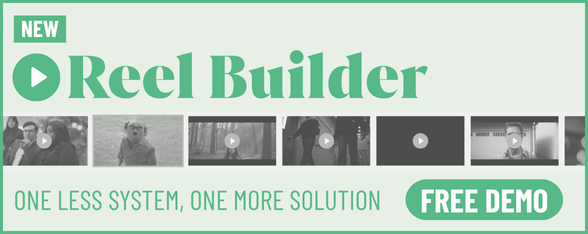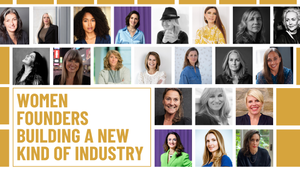
Producing Tomorrow's Producers: Being AI-Forward with Gina Fallon

Gina has developed and produced multiple award-winning campaigns in both live-action and animation spaces. She began her career as a creative director, designing and producing large-scale corporate events in the experiential space for Fortune 500 companies, including United Airlines, CSX, TIAA, and many more.
A natural storyteller with a magnetic personality, she draws on her keen visual design skills fostered through a lifetime pursuit of art and experience in leading creative productions. Highly regarded for her ability to motivate talent, elevate content, and develop efficient production pipelines, from concept all the way through delivery, Gina has positioned TigerLily to scale at every opportunity. Her strategic and detail-oriented production style never loses focus on the importance of good storytelling.
LBB> What advice would you give to any aspiring producers or content creators hoping to make the jump into production?
Gina> If you’re anything like me, you’ll want to dive in and be great. Quick satisfaction is the world we live in. But, so much of your career will depend on your foundation. I believe the best foundation is built with the help of mentors.
I’ve had the incredible fortune of working under two different female business owners at the start of my career. As I work with up-and-coming producers, I find myself constantly passing on the same knowledge they shared with me. There is so much to learn from the leaders before us.
If you’re willing to be patient, be open, take the bottom slot on the call sheet, and be a sponge and even a friend, you will find yourself equipped with the tools to keep growing and growing.
LBB> What skills or emerging areas would you advise aspiring producers to learn about and educate themselves about?
Gina> AI-forward!
At TigerLily, we have an invaluable business growth strategist who refers to herself as an evangelist of 'AI for Good.' She is helping me learn all the ways AI can support a producer. Beyond the amazing things it can do to make us more efficient in day-to-day tasks, there’s going to be a whole new pipeline for working with AI, from prep to production to post.
Staying on top of what’s being made in AI, how it will move through a pipeline, what roles we will soon need to support this and how can we make sure our artists are still making the art… this is the work every producer should be doing right now.
LBB> What was the biggest lesson you learned when you were starting out in production - and why has that stayed with you?
Gina> I have always enjoyed making things. Ideating, creating, and sharing - this is what drives me. I floated a bit in my early career, but the core of my work was always built on those three things.
When I started as a producer, I was a dreamy-eyed 20-something who was so invested in making a great story, I crossed the lines into every department on my first few sets. And boy, was I put in my place by a crew member one day.
It was a major lesson in a few major ways. First and foremost, respect each department head. Second, slow the f* down. And last, but most importantly, I learned that I wanted to do things differently.
I want to do away with the 'stay in your lane' mentality and do more work with people that see value in the team as a whole, just working together to tell a good story.
LBB> When it comes to broadening access to production and improving diversity and inclusion what is your team doing to address this?
Gina> If we’re making a piece about the women of Iran, we’re going beyond casting; we’re seeking Iranian women to co-write, art direct, score, and colour…
As we shoot different cultures around our country, we’re intentional about selecting key crew from the same community, rather than traveling in the same teams we’ve always worked with.
Our favourite work is around giving voices to the underrepresented. Our company is owned by the underrepresented. We want to do more than tell a story about these people. We want to create alongside them.
LBB> And why is it an important issue for the production community to address?
Gina> It’s a chance for us all to learn from new ideas, new perspectives, and new takes on the world we share.
LBB> There are young people getting into production who maybe don’t see the line between professional production and the creator economy, and that may well also be the shape of things to come. What are your thoughts about that? Is there a tension between more formalized production and the ‘creator economy’ or do the two feed into each other?
Gina> Personally, I see a line between the two. But I don’t think that’s a bad thing. I’ve never believed in the one-size-fits-all mentality.
I believe there is work for both sides of production - professional commercial and creator economy. We rarely do the same work or produce in the same way, nor do we want to.
If you want to do or be something, find a way. That’s why I admire the creator economy industry. They are making it happen for themselves.
Professional production suits me, but there isn’t just one way to create good content.
LBB> If you compare your role to the role of the heads of TV/heads of production/Exec Producers when you first joined the industry, what do you think are the most striking or interesting changes (and what surprising things have stayed the same?)
Gina> There are a lot more women! Hooray!
I think producers are doing a lot more with a lot less. We’re more involved in the creative (thankfully) and it’s more collaborative than ever.
The biggest and most exciting change I’ve seen is the new approach to production from companies like Artists Equity. THIS is exciting to me.
I’ve always hated the part of the industry that negotiates our crew down to their lowest possible rate, then buys seafood towers for clients and above-the-line talent. Happy to see these guys lead the charge in flipping the switch.
LBB> When it comes to educating producers how does your agency like to approach this? (I know we’re always hearing about how much easier it is to educate or train oneself on tech, etc., but what areas do you think producers can benefit from more directed or structured training?)
Gina> I teach the way I learn best - with a seat at the table. Be at every pre-pro meeting, listen in on every discovery call, be in the middle of a fiery budget meeting, wear comms and listen to every on-the-fly decision we make on set, and wrap every penny next to me. I use new systems and I use old systems. I’m a producer, so efficiency is the name of the game. I will teach you all I know, but if you find a faster, better way, then teach me. I’m wide open.
LBB> It seems that there’s an emphasis on speed and volume when it comes to content - but where is the space for up-and-coming producers to learn about (and learn to appreciate) craft?
Gina> If you’re in it to get a project from point A to point B as fast and alongside as many as possible… I don’t know. Why work in filmmaking? There’s got to be a better place for you than this.
If you’re truly here for the craft - which please let that be a 'yes' - you have to do the work yourself. Watch everything. Find a style, an artist, or a piece that fills you up. Dissect it. Learn from it. That’s the work that happens between the work. The nights and weekends and coffee breaks. It’s the 'why' behind everything else you have on your to-do list. Make it a priority.
LBB> On the other side of the equation, what’s the key to retaining expertise and helping people who have been working in production for decades to develop new skills?
Gina> I think it’s important to surround yourself with younger generations to inspire you and push you past your comfort zone. I’ve always heard from our founder, “I keep you guys around to keep me relevant.” It’s a great mentality to keep you growing.
LBB> Clearly, there is so much change, but what are the personality traits and skills that will always be in demand from producers?
Gina> Being a leader, a good communicator, an organiser, a prioritiser… all the makings of a logistics guru, which are necessary to produce well.
But that’s only one side of the equation. The other side is the creative. The best part. No one else in the pipeline, besides the writers and directors, gets to watch the story evolve from the first discovery call to the script, to pre-pro, to the boards, to the production, to the editor, to the designer, to the colorist, to the audio mastering, to the finishing.
You get to be inspired by how stories are told and take that into your work every day. You get to build a team, then make them stretch. You get to be the hard-ass and the cheerleader. And the ultimate story champion. If this makes you feel something - do it. And call me, I’d love to work with you.















